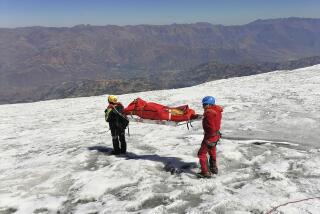Message in a bottle found 54 years later in Arctic
A message in a bottle, buried 54 years ago under a rock cairn in a remote Arctic valley on Canada’s northernmost island, could well be the last written words from a promising young glaciologist and explorer from Pasadena.
The words from Paul T. Walker, penciled on July 10, 1959, were a simple request to measure the distance to a nearby ice shelf on Ward Hunt Island, and report them back to his laboratory at Ohio State University, or to his colleague, Albert Crary, in Cambridge, Mass.
But Walker, a 1956 Occidental College geology graduate, never returned to that Columbus, Ohio, laboratory. A massive stroke weeks later left him paralyzed. After a harrowing rescue by a bush pilot, Walker returned to his parents’ home in Pasadena, where he languished, paralyzed, until he died on Nov. 11, 1959. He was only 25 but had already been part of major expeditions near both poles.
Crary, who reached the North Pole in 1952, went on to an impressive career and led a mission to the South Pole in 1961. The U.S. Arctic Program’s Science and Engineering Center at McMurdo Bay, Antarctica, is named for him.
“I recognized the two names instantly,” said biologist Warwick F. Vincent, director of the Center for Northern Studies at Laval University in Quebec City, who revealed the find last week at a conference in Halifax, Nova Scotia.
“Walker is a famous name in our parts up there because the highest point on Ward Hunt Island is called Walker Hill,” Vincent said. “And we’ve been camping next to Walker Hill now for over 10 years.
“Albert Crary – that actually gave me goose bumps to read that name on the sheet of paper. And there we were, holding a piece of paper with his name on it. He’s a very famous character in north polar science and south polar science.”
Jim Lotz, a historian in Halifax, knew Walker well. “He was a buddy of mine,” Lotz said by telephone. “We were on the ice shelf in 1959 together, and he had a stroke. He was on a field party and I was on the edge of the ice shelf, in a trailer.”
Vincent and his colleague, Denis Sarrazin, landed at the remote valley last summer on a whim, having taken a detour en route back to their base camp from a remote fjord. They thought the small valley looked suitable for collecting microbes.
While Vincent collected samples, Sarrazin wandered away and found the cairn near the face of the ice sheet. When the two disassembled the cairn, they found a small, 250-milliliter plastic sample bottle with a piece of torn notebook paper tightly rolled inside, Vincent said.
“To Whom it May Concern: This and a similar cairn 21.3 feet to the west were set on July 10, 1959. The distance from this cairn to the glacier edge about four feet from the rock floor is 168.3 feet.
“Anyone venturing this way is requested to remeasure this distance and send the information to: Paul T. Walker, Department of Geology, The Ohio State University, Columbus 10, Ohio, USA and Mr. Albert P. Crary, Air Force Cambridge Research Center, 11 Leon St., Boston 15, Mass. USA. Thank you very much.”
Walker signed his name.
“We were reading some of his last words,” Vincent said. “He didn’t know at that stage whether the glacier was advancing or retreating. But he wanted a reference point that would allow future researchers in the area to provide him with important data.”
The two remeasured the distance -- with GPS equipment and by pacing it off -- and found the ice sheet has retreated more than 200 feet, Vincent said.
Without modern equipment, the journey to that valley, where average temperatures hover at about zero degrees Fahrenheit, would have been arduous in the late 1950s, Vincent said.
“Ward Hunt Island already is the middle of nowhere. This is nowhere from nowhere,” Vincent said. “It’s an incredibly hidden valley, well off any kind of beaten track that anyone would pass across. And this is the reason that this cairn and its treasure have been lost for 54 years.”
For his part, Lotz said he was shocked to find out about the message from his friend, originally reported Dec. 12 in the Halifax Chronicle Herald.
“I was just so pleased because it brought Paul back, in a way, and the work he had done,” Lotz said. “Because he had a brilliant career as a glaciologist and all of a sudden, to be cut short that way.”
Lotz and Walker had spent several spring weeks killing time in Cambridge, Mass, waiting for the U.S. Air Force arctic mission to begin. The Pentagon at the time was interested in finding suitable areas for a potential airstrip for bombers during the Cold War.
Just before flying to Ellesmere Island, they saw a movie whose title Lotz later considered ominous: “Celiu qui doit mourir,” or “He Who Must Die.”
“We just struck it off together, became good buddies,” Lotz said. “We were very similar in temperament, outlook and tastes. In the Arctic, you live at the basic level: food, shelter, work and friendship. That’s all there is to it. And you don’t need more than that, quite frankly.”
Their lives, Lotz recalled, were cut from the script of Indiana Jones or “The English Patient” --- adventurous, stimulating and perilous. Walker had already driven to Alaska, and been part of a perilous Antarctic expedition. Lotz had wandered North Africa.
The pilot who came to evacuate Walker, Lotz recalled, was Welland Wilford “Weldy” Phipps, a former Royal Canadian Air Force pilot who had been shot down during World War II, held captive in Germany for two years, and escaped. He had invented balloon-like tires, known as “Weldy specials,” for landing on tundra.
Moments after Phipps took off for Greenland’s Thule air base, with Walker aboard, dense fog and bad weather rolled over the coast, Lotz recalled.
“We were people who took risks,” Lotz said. “We liked it -- never made a big thing out of it. He was such a great guy; He was free and easy, the best of the California culture.”
At Occidental, Walker ran track during his freshman year, as a miler and two-miler, when that team defeated the USC freshmen in a head-to-head dual meet and then went on to win the conference championship, according to college spokesman James Tranquada. Walker won the two-mile run at that 1953 championship meet, he added.
Six years later, he lay dying at his parents’ home. Lotz headed there to visit Walker in September after the 1959 arctic expedition ended.
Lotz said he never knew much about Walker’s Pasadena childhood but believed he was an only child. His parents were middle-class, “very, very ordinary Americans,” he said.
“He had a really good nonchalant attitude toward life,” Lotz said. “But I remember when I saw him in his parents’ home in Pasadena, I just remember the fear in his eyes. That was it. I think he knew that was it.”







